Kodak G600 Printer Dock Review
Kodak G600 Printer Dock
Kodak makes printing your snaps easy with this portable dock.
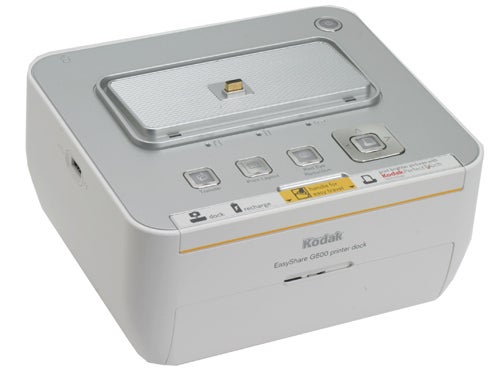
Verdict
Key Specifications
- Review Price: £92.73
Kodak as a company is one of the founding fathers of photography, but for a while seemed to have lost its way in the transition from film to digital. In recent years though, it seems to have regained direction. Rather than go for the high-end camera market, Kodak focuses on making digital photography easy, which for the less technologically inclined it still isn’t.
The EasyShare G600 printer dock is a great example of this philosophy. Similar to the EasyShare Series 3 Printer we reviewed at the beginning of the year, it lacks that models Wi-Fi and Bluetooth support, but instead adds a large battery pack and a carry handle, with an clear eye on portability. The weight comes in a 1.1Kg, which isn’t insubstantial, but it’s still very practical to put in a bag and go.
It’s not too hard to see the appeal of this – snap away at say, a children’s party, and you can send all the kids home with a picture of themselves, all without having to worry about cables for camera or PC. Of course, this works best if you have a compatible Kodak camera to place onto the connector at the top of the dock. However, even if you don’t have a Kodak camera, you’re not left out of the printing party – the dock is PictBrige compatible so you can connect up, (via the USB port of the left hand side) to any compatible camera from another manufacturer. Alternatively, you can just hook up to your PC via USB and print from there.
The printer is a squarish looking device, with the aforementioned Kodak camera dock area on the top. In front of this are four buttons, used for browsing and selecting pictures from a Kodak camera seated on the dock. For a PictBridge device, you would use that device. In front of these buttons is the handle, which simply pulls outward. To the right of the camera dock area is the large power switch which glows green when plugged into the mains, orange when powered by the battery, and flashes green when the battery pack is connected and charging. The dock will also recharge the battery of any compatible Kodak camera affixed to the dock.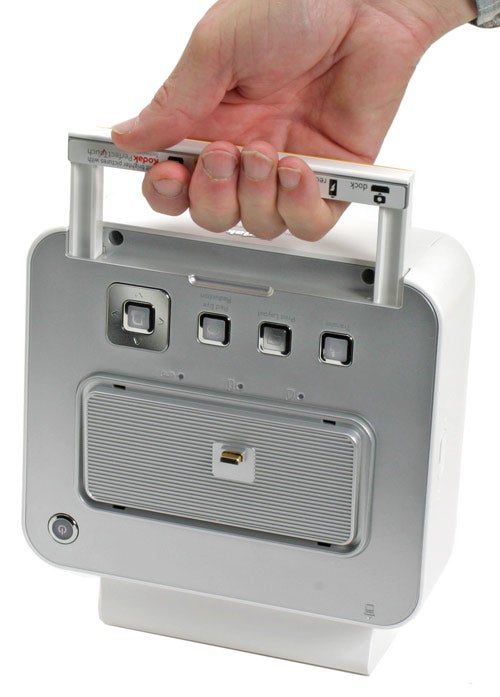
Connecting the battery could hardly be easier – the panel at the rear just pops off and the battery clips on. The battery is a rather chunky affair, though it needs to be to get through the 65 sheets of paper that Kodak claims it can print. Also at the rear are the power supply connector and the USB uplink port.
As well as providing PictBridge compatibility, the USB port on the left enables you to print from a USB memory key, provided you have a Kodak camera docked, enabling you to preview the pictures on the screen. Alternatively, you can use it to copy pictures from the camera to the USB key, in order to free up some space – potentially very handy if you’ve no PC to hand.
On the right hand side is the photo paper kit – you simply pop the one piece cartridge into the slot, close the door and you’re ready to go. It reminded me of loading film on an APS camera – fairly idiot proof. 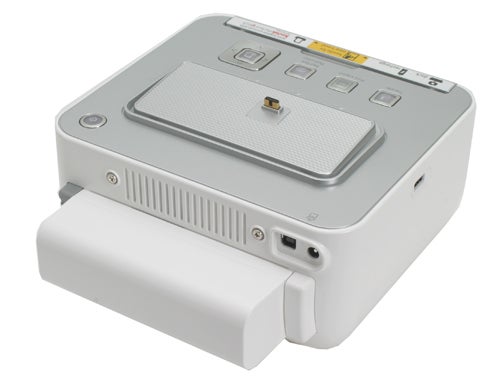
At the front is the paper tray. By design the dock only handles 6 x 4in paper, so if that’s too small for you, you’ve been reading this review for too long anyway. This tray can hold up to 30 sheets in one go.
Printing via a PC proved to be very easy, via the supplied Kodak EasyShare software. I must admit I was briefly flummoxed how to stop the software printing to my existing printer by default – I was selecting ‘Quick Print’ and failed to noticed the, actually quite glaringly obvious ‘Print at Home’, option on the left hand side, which enables you to select the Printer of your choice. It makes sense to use the EasyShare software as it is optimised for the dock, enabling you to make best use of the paper size, printing without borders and putting multiple images onto one print if so desired.
The EasyShare software is pretty slick for free bundled software and integrates well with Kodak’s Gallery, from where you can order more advanced items such as Photobooks, T-Shirts and the like. The software has built in image enhancement options for a quick one-click fix, but I found that Adobe’s Photoshop Elements 5 did a better job at enhancing colours.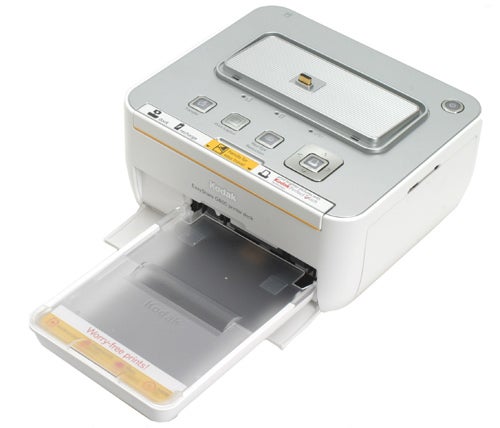
The big advantage of this sort of dock is that, as advertised on the paper tray, prints are ‘Worry-free’- namely, waterproof, fingerprint proof and stain resistant. In other words, they’re more real-world friendly than the average ink-jet printer. In terms of quality, there’s nothing complain about. Colours are natural and images are free of visible dot structure, grain, banding or any of the other potential downfalls of conventional inkjets.
You have to wait for those quality prints though. From a PC, I found that each print took one minute five seconds each time to hit the deck. It’s not lightening fast considering the modest size of the prints, and slower than Simon got from the EasyShare Printer Dock Plus Series 3.
The reason for the relatively leisurely pace is that the print technology here is based on continuous-tone, thermal dye transfer – this means that colours are put down in layers along with a special laminate coating providing the protection. As a result, the paper comes out of the printer and then gets sucked in again three times before the final picture emerges.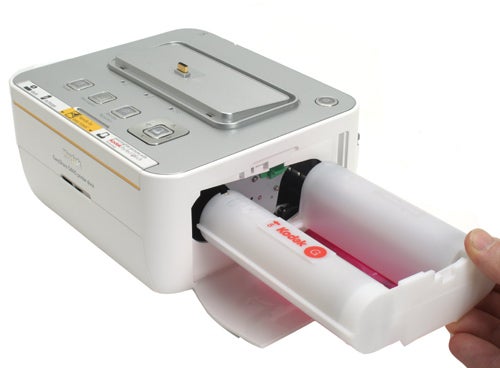
When it comes to replacing the photo pack you get a cartridge and exactly the amount of paper for that cartridge in one box. This is again proof of the keep-it-simple Kodak approach and also makes it very easy to work out printing costs. At £39.99, the 200 print pack is the best value and comes in at 19.9p per print, which isn’t bad, though that compares to inkjets printing an A4 sheet – not a measly 6 x 4in.
As for the price of the printer itself, at the RRP of £129 it’s reasonable but finding it online for only £93 makes it even more attractive. However, compared to the Series 3, its main sell is its portability, so if you don’t need that I’d go for that instead with its extra benefits of Wireless support.
If portability is key though, the G600 is a very cute little device. It’s breathtakingly easy to set-up and use, relatively cheap to run and makes printing very easy. It was all I could do to stop myself easting up my paper by popping off prints of pictures left, right and centre.
”’Verdict”’
It’s best paired with a Kodak camera, it’s a little slow and you have to be satisfied with 6 x 4in prints, but as long as you are happy with all of those, this is a fun, feisty, and very portable printer that produces excellent quality prints with reasonable running costs.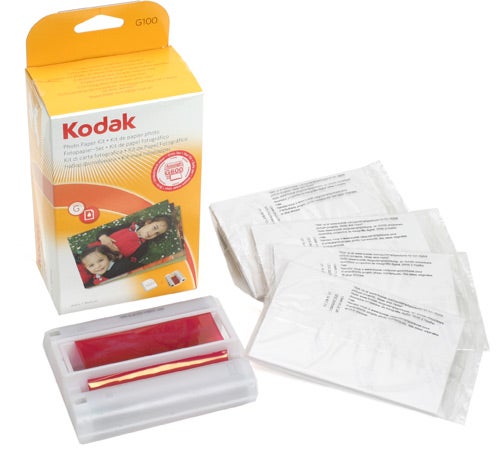
Trusted Score
Score in detail
-
Print Speed 6
-
Features 9
-
Value 8
-
Print Quality 10
Printing
| Paper Size | 4" x 6", 3" x 4", 2" x 3", 1.30" x 2" |
| Sheet Capacity | 30 |

